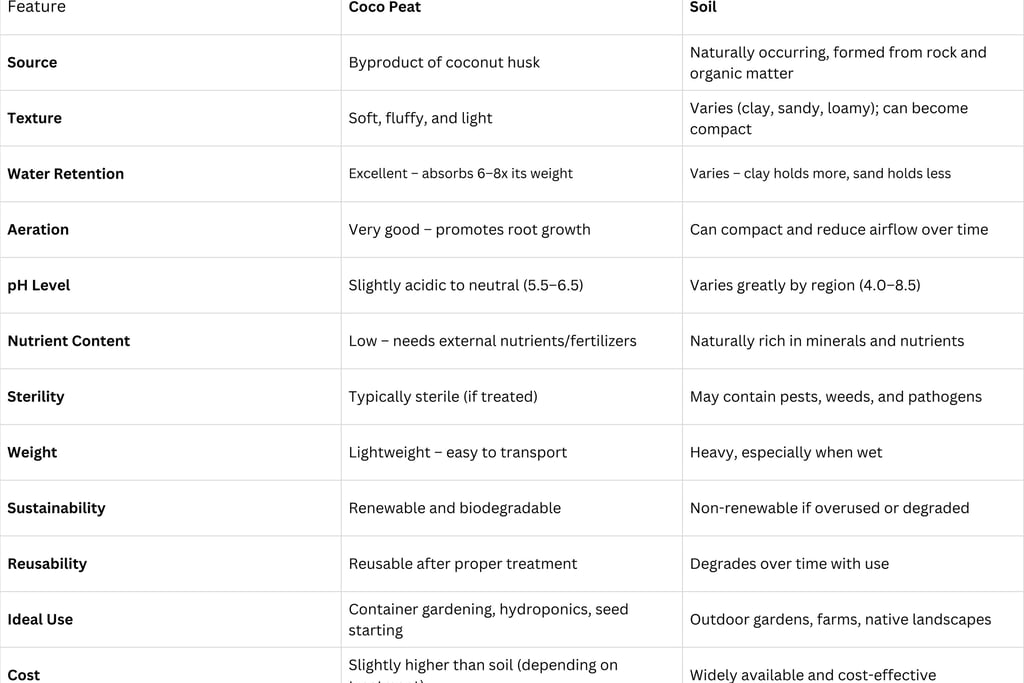Coco Peat vs Soil: Which is Better for Your Plants?
Discover the key differences between coco peat and soil in this in-depth guide. Learn which growing medium is best for your plants based on water retention, nutrients, sustainability, and more. Ideal for home gardeners, greenhouse growers, and sustainable farming.
7/13/20252 min read


Introduction
Choosing the right growing medium is essential for healthy plant growth. Traditionally, soil has been the go-to medium for most gardeners and farmers. However, with increasing interest in sustainable and efficient gardening practices, coco peat has emerged as a popular alternative. This article provides an in-depth comparison between coco peat and soil, examining their characteristics, benefits, and drawbacks to help you determine which medium is best suited for your plants.
What is Coco Peat?
Coco peat, also known as coir pith or coir dust, is a byproduct obtained from the husk of coconuts during the coir fiber extraction process. Light brown and spongy, coco peat is known for its excellent moisture retention and aeration properties. It’s often used in compressed blocks or briquettes that expand when soaked.
Used widely in seed germination, container gardening, and hydroponics, coco peat is biodegradable, renewable, and eco-friendly—making it a go-to for sustainable agriculture.
What is Soil?
Soil is a natural blend of minerals, organic matter, air, and water. It forms over millennia and provides vital nutrients and microbial life for plants. Its texture can be sandy, loamy, or clayey depending on mineral content. While soil is nutrient-rich, it can be inconsistent and may contain pests or pathogens, requiring treatment or supplementation in many cases.
Coco Peat vs Soil: A Comparison
Coco peat holds up to 6–8 times its weight in water, which is a major advantage in dry climates or for water-sensitive plants. Its structure promotes airflow, making it hard to compact—great for healthy root development.
Soil varies widely: clay retains water well but may compact easily, while sandy soil drains quickly but doesn’t retain nutrients. Coco peat is naturally sterile and has a slightly acidic to neutral pH (5.5–6.5), whereas soil may host pests, weeds, and fungi and can swing in pH.
Coco peat is also lightweight and easy to handle—perfect for urban or rooftop gardens. Soil, though heavier, offers long-term nutrient supply and better support for large outdoor plants. Environmentally, coco peat is a sustainable byproduct, while soil—if overworked—can degrade over time.
Which One Should You Choose?
If you're into container gardening, hydroponics, or indoor plants, coco peat is a top pick for its consistency, water control, and disease resistance. It's ideal in places where soil is poor or contaminated.
If you're managing outdoor gardens, landscaping, or traditional agriculture, soil is still the go-to for its nutrition and structure. However, many professionals use a blend of both—coco peat for aeration and water management, soil for its nutrients and microbial richness.
Conclusion
Both coco peat and soil offer unique benefits. Coco peat is lightweight, sustainable, and clean. Soil is nutrient-rich and time-tested. For many growers, the winning formula lies in combining both to maximize growth, yield, and sustainability


Fonir Global Pvt. Ltd.
QUICK LINKS
© 2025. All rights reserved.


OUR PRODUCTS
